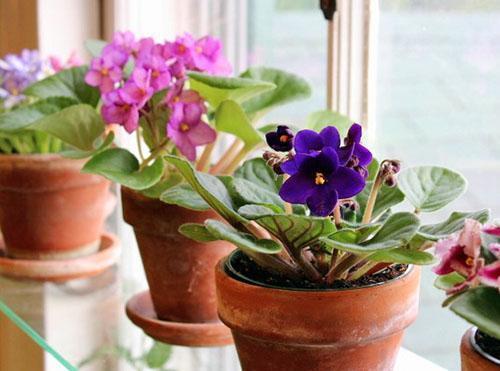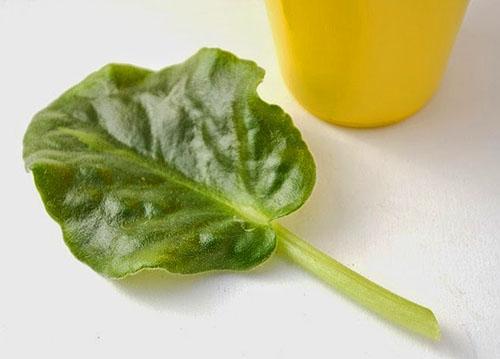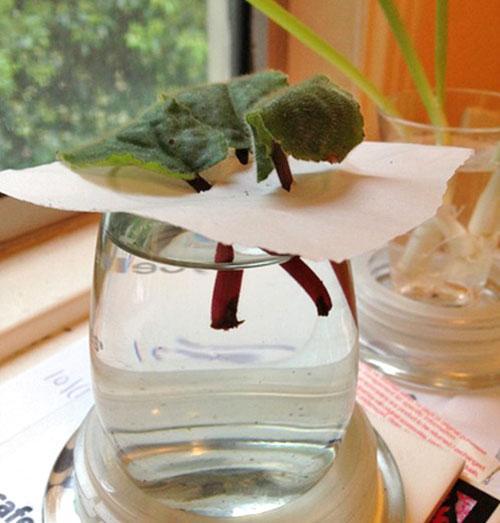Reproduction of violets at home with a leaf
 When uzambar violets appear on the windowsill, the florist will definitely want to expand the collection at the expense of other varieties or get new sockets from the existing ones. Most often, at home, violets are propagated by leaves cut from an adult plant you like.
When uzambar violets appear on the windowsill, the florist will definitely want to expand the collection at the expense of other varieties or get new sockets from the existing ones. Most often, at home, violets are propagated by leaves cut from an adult plant you like.
This is the simplest and most common way of growing young rosettes, which will be easy to master even for beginners who have only recently become interested in such an amazing crop as Saintpaulia.
A favorable time for the reproduction of violets is the spring and summer months, when the plants have enough heat and light. But if necessary, for example, if planting a violet with a leaf is the only way to save a rare variety, then an experienced florist can carry out his plans during a short daylight period.
Read also the article:streptocarpus care and cultivation!
Selecting and obtaining a leaf for propagation of violets

Therefore, before growing a violet from a leaf, they are very careful about its choice. Experienced growers advise not to use leaves from the lowest tier close to the ground for reproduction. They are the oldest, perhaps already weakened, besides, on such leaf plates, there is a high probability of settling bacteria and fungal spores.
It is best to cut a stalk from the second or third tier, where the leaves are sufficiently formed, have reached adult size and have a pronounced turgor.
Sometimes the planting material turns out to be drooping, having lost its appearance and elasticity. This happens if they want to get a new outlet from a sheet purchased in a store, sent by mail from a nursery or received from friends.
Long road and sometimes just irregular watering quickly affect the condition of the leaf plate and the handle. Therefore, it is better to put such a leaf, intended for reproduction of violets, in warm boiled water for a couple of hours before planting, where several crystals of potassium permanganate have been added. This measure will allow the sheet to return to its previous state and disinfect it.
Then the cutting of the leaf dried on a napkin is carefully cut with a sharp knife at a distance of 3-4 cm from the base of the leaf blade. The cut can be either straight or at an angle of 45 °.
Rooting a violet propagation leaf in water
The faster the cut leaf gets into the water, the easier and faster the root formation process will go.
 For a beginner who has never been involved in breeding violets before, the easiest way to root a leaf is in boiled or settled water. This will allow:
For a beginner who has never been involved in breeding violets before, the easiest way to root a leaf is in boiled or settled water. This will allow:
- accurately track the state of the planting material;
- in time to prevent rotting of the cutting;
- see the formation of the root system and the beginnings of future rosettes.
Before the violet propagation leaf is lowered into water, the container is thoroughly washed, and if it is a lot of disposable dishes, then sterilized. It is best to use small glasses or dark glass vials to prevent green algae from forming on the sides of the vessel and contaminating the water. the procedure for the rooting procedure:
- The sheet is buried 1.5-2 cm.
- The cut of the cutting should not touch the vessel, for which the sheet can be fixed with a sheet of paper or a lid on a container with water.
- To prevent the development of pathogenic bacteria and microscopic algae, an activated carbon tablet is dipped into the water.
- Evaporating moisture is gradually added again, using only settled clean water, trying not to wet the sheet plate and not changing the initial level of the liquid.
Depending on the variety and condition of the leaf chosen for reproduction of violets, the appearance of roots can be seen after 2-4 weeks.
If, despite all the efforts, not roots, but traces of rot appeared on the cut, the leaf is taken out of the water, dried and carefully trimmed, removing damaged tissue. The same coal will help prevent rotting, only in this case - crushed into powder. A new cut is processed with it, and then the sheet is again immersed in water.
With traces of decay, the water is changed, and the container is disinfected.
When strong numerous roots 1–2 cm long have developed on the cutting of the leaf, it is time to transfer the leaf to the soil mixture.
 In some cases, flower growers do not take out the planting material from the water until tiny rosettes are formed on the handle. And already they are dropped into the nutrient substrate. However, there is a danger of weakening the sprouts, slowing down the growth and development. To grow a violet from a leaf that has already given roots, take small plastic glasses or pots with holes to drain the water. The vessels are filled by a third with shallow drainage, then the glasses are filled almost to the top with soil.
In some cases, flower growers do not take out the planting material from the water until tiny rosettes are formed on the handle. And already they are dropped into the nutrient substrate. However, there is a danger of weakening the sprouts, slowing down the growth and development. To grow a violet from a leaf that has already given roots, take small plastic glasses or pots with holes to drain the water. The vessels are filled by a third with shallow drainage, then the glasses are filled almost to the top with soil.
How to plant a violet leaf in the soil? First of all, the stalk and the leaf itself should not be too deep. Otherwise, the resulting sockets will take a long time to break through to the surface, weaken or may not hatch at all. Around the cuttings, the soil is compacted, moistened, and in this form the pot is placed in a greenhouse or covered with a bag to create a favorable atmosphere for the reproduction of violets and retain moisture. If at the same time the florist is going to grow violets of several varieties from the leaves, the pots are equipped with the appropriate inscriptions about the name of the plant and the date of its planting.
Plants are removed from the greenhouse or from under the film after the young foliage appears above the ground level. As a rule, it may take at least two weeks to wait for this moment.
Rooting a violet leaf in the potting mix
 The leaves planted immediately in the ground take root well, and the process of growing violets from a leaf cuttings is much faster. This method is irreplaceable when a leaf was taken from a still young immature plant for reproduction of violets, or, conversely, the planting material was obtained already withering.
The leaves planted immediately in the ground take root well, and the process of growing violets from a leaf cuttings is much faster. This method is irreplaceable when a leaf was taken from a still young immature plant for reproduction of violets, or, conversely, the planting material was obtained already withering.
The leaf is prepared in the same way as in the first case, but the cutting on miniature varieties is shortened even more, leaving only from a centimeter to one and a half.
Small cups or pots with a volume of up to 100 ml and a diameter of about 5 cm are well suited for planting. The containers are filled by a third with drainage material. If it is expanded clay, it would be nice to bake it in the oven to minimize the risk of spreading fungal and mold infections.
 Next, the soil mixture is poured into the glass and a hole is made for the cutting. To fill this groove, not ordinary soil is used, but mixed with perlite for looseness. In this case, it will be easier for small outlets to develop and receive the necessary air.
Next, the soil mixture is poured into the glass and a hole is made for the cutting. To fill this groove, not ordinary soil is used, but mixed with perlite for looseness. In this case, it will be easier for small outlets to develop and receive the necessary air.
Sometimes you can see tips for growing violets on pure perlite. However, such a decision can result in the death of immature plants, since perlite without other soil components does not hold moisture well and dries quickly.
The composition of soil for violets includes not only perlite, but also sphagnum moss, which retains water and has an antibacterial effect.
The potting soil should be slightly damp when planting. Planting material is buried in the ground no more than 5 mm for miniature varieties and 1–1.5 cm for standard-sized violets.By watching a video on how to propagate a violet with a leaf, you can learn a lot about the intricacies of this process and subsequently avoid annoying mistakes. Several sheets can be planted in one cup, the main thing is that they are of the same grade and carefully marked.
 As in the first case, when cuttings with formed roots were planted in the soil, the soil is squeezed a little, moistened, and the glass is placed in a greenhouse. So that mold does not form on the soil and the plants do not rot, from time to time the planting is aired, protecting it from drafts and cold air.
As in the first case, when cuttings with formed roots were planted in the soil, the soil is squeezed a little, moistened, and the glass is placed in a greenhouse. So that mold does not form on the soil and the plants do not rot, from time to time the planting is aired, protecting it from drafts and cold air.
A good result is obtained by planting leaves intended for reproduction of violets in peat tablets. Due to the loose, nutritious substrate, plants quickly form roots and young rosettes.
 How to grow a violet from a leaf? What conditions are important for a young plant, and how to care for the sprout so that it successfully and quickly takes root? The main condition for the success of the growing process can be considered constant attention to the tiny violet plant, which is provided:
How to grow a violet from a leaf? What conditions are important for a young plant, and how to care for the sprout so that it successfully and quickly takes root? The main condition for the success of the growing process can be considered constant attention to the tiny violet plant, which is provided:
- light nutritious soil permeable to air and moisture;
- stable growing temperature of about 22–26 ° C;
- daylight hours lasting at least 12 hours;
- regular and even watering;
- constant humidity and wind protection.
 Violets feel very good on racks equipped with backlit from phyto-lampsproviding plants with comfortable growing conditions even in autumn and winter.
Violets feel very good on racks equipped with backlit from phyto-lampsproviding plants with comfortable growing conditions even in autumn and winter.
The composition of the soil for violets and its preparation
 The soil mixture for planting violets with a leaf is prepared in advance, necessarily a day before the plant enters the ground, disinfecting it and mixing it with all the components and fertilizers.
The soil mixture for planting violets with a leaf is prepared in advance, necessarily a day before the plant enters the ground, disinfecting it and mixing it with all the components and fertilizers.
As a basis for the substrate, you can take ready-made soil for violets or seedlings of garden crops. But experienced flower growers promise the best effect if you make the mixture yourself. Moreover, there are many interesting soil compositions for violets. One of them was proposed by the famous breeder B. Makuni:
- 1 part leaf humus;
- 3 parts peeled horse peat;
- 1 part of clean sand;
- 2 part green moss;
- 1 part sphagnum;
- 1 piece of garden land.
Today, more and more often for soil mixtures for growing violets, substances such as perlite and vermiculite are used, which provide a good soil structure and its friability. To disinfect the soil and its quality, crushed charcoal and sphagnum are introduced into the soil. You cannot overdo it with the last component, otherwise the soil turns out to be moisture-absorbing, and the roots of violets in it can rot.
If sphagnum is used in soil for violets, it is crushed. In general, this moss is good for drainage in small pots.
Separation of new rosettes when propagating violets with a leaf
 The formation of several daughter rosettes with a diameter of 3 to 5 cm at the base of the leaf indicates that it is time to plant the plants. If variegated violets are propagated with a leaf at home, the daughter plants must be green by the time of transplantation, otherwise the white leaves will not be able to provide power to the acclimatizing outlet.
The formation of several daughter rosettes with a diameter of 3 to 5 cm at the base of the leaf indicates that it is time to plant the plants. If variegated violets are propagated with a leaf at home, the daughter plants must be green by the time of transplantation, otherwise the white leaves will not be able to provide power to the acclimatizing outlet.
At the same time, the children will have to be divided in such a way that each tiny outlet has at least one pair of leaves with a developed growth point and a certain number of roots.
 To make the separation less traumatic for violets:
To make the separation less traumatic for violets:
- the soil in the pot is well moistened;
- the plant is removed along with the soil clod;
- gradually clear the roots of soil.
For reproduction of violets of such tiny sizes, they take the smallest pots with a diameter of up to 4 cm, where they transfer the daughter rosettes, without deepening, like cuttings, before that.
 It is better to plant children with an insufficient number of roots not in the ground, but, like a leaf cutting, in a mixture of soil and perlite. Such a plant is placed in a greenhouse for 10-14 days or on a film.
It is better to plant children with an insufficient number of roots not in the ground, but, like a leaf cutting, in a mixture of soil and perlite. Such a plant is placed in a greenhouse for 10-14 days or on a film.
The grown rosettes are transplanted to a permanent place when their diameter exceeds the size of the pot by 1.5–2 times.In this case, plants will need containers with a diameter of up to 6 cm, and it is better to transfer violets in them together with the existing earthen clod, and the new soil is poured to the bottom and around the circumference, sealing the rosette in the pot.
Reproduction of violets by a leaf - video
https://www.youtube.com/watch?v=sWcy8X-IOso
Hello. Please tell me how to plant violets, if she does not have families, but just twigs.
If you want to teach a new plant, try rooting a leaf. I would not sit down. A lush bush always looks better than single outlets.